2016 Yamaha VXS vs. Sea-Doo GTR 215
Flagship performance levels at a mid-tier price
For all the feature-laden craft that occupy current product lines, two boats stand out for their simplistic approach to good old fashioned performance – Yamaha’s VXS and Sea-Doo’s GTR 215. Both mix a powerful engine in a hull that is otherwise used for recreational models, exploiting the overall power-to-weight ratio to get customers a craft that does flagship speeds but doesn’t cost a flagship price.
Here’s how they compare.
Building Blocks
Yamaha was first to try the idea years ago. Its craft – the two-passenger VXR and the three-passenger VXS – borrowed the hull and deck design from the lower-cost VX line, and paired it with the brand’s big-displacement 1.8-liter engine. Foregoing a supercharger lowered the price, kept ongoing fuel costs low as well, and relied on the adage “there’s no replacement for displacement.” It worked. For a fraction of the price of a flagship, buyers got a craft that did a flagship’s 65 mph, accelerated very aggressively from idle, and thanks to aggressive sponsons and a race-inspired rideplate, carved with tenacity on the water.
Sea-Doo followed suit shortly after, employing the same tactics. The hull and deck were borrowed from the GTI line, which like the VXR, handled the added power surprisingly well, showing off a side of its personality most consumers probably didn’t expect. For an engine Sea-Doo also looked to its existing line, choosing the 1,494cc Rotax that’s carried nearly the entire line over recent years. One big difference? Sea-Doo chose a more powerful 215 hp variant of that engine, which retained a supercharger and intercooler. The additional performance hardware gave Sea-Doo an edge in low-end acceleration, but also equated to a greater thirst for fuel. In Sea-Doo’s case, that’s a recommended 91 octane; Yamaha requires only 87.
Read our review of the 2015 Yamaha VXS
Both craft peak at similar speeds, in the neighborhood of the magic 65 mph mark. A new VX hull introduced recently traded a little top speed for superior overall handling. Sea-Doo likely holds a slim edge depending on conditions, rider weight, and riding style.
Reverse/Deceleration
Both Yamaha and Sea-Doo offer their enhanced electronic control systems, RiDE and iBR. The similarities are many. Both use the reverse bucket and a lever on the left side of the handlebars to interrupt thrust exiting the pump. At startup, that thrust is diverted just enough to keep both boats relatively motionless. Users can also use the systems to enjoy precision low-speed control in forward and reverse, as well as rapidly decelerate at speed. Both keep eyes on the water and hands on the handlebars, and both are quite intuitive, requiring only a brief practice before the rider feels proficient.
Where they differ is that Sea-Doo markets iBR as a brake, while Yamaha does not. iBR also acts more like traditional boat gearing, shifting the boat in and out of forward, neutral and reverse motions while relying on the throttle for any corresponding power. In contrast, Yamaha’s RiDE lever acts as a secondary throttle. When applied at low speeds it overrides the normal throttle to propel the boat backwards. When it’s applied at high speeds that same overriding thrust is applied to rapidly slow the boat down. There’s no feeling of shifting in and out of gears, and no real hesitation. Both systems work exceptionally well; users may just find they may prefer one approach to the other.
Beyond RiDE/iBR, Sea-Doo holds a slight edge in terms of extras. The GTR offers the brand’s Intelligent Throttle Control, which lets the driver choose a more powerful Sport mode or a tamer Touring mode. An ECO mode is also available to maximize fuel savings. Both Sea-Doo and Yamaha offer electric trim, with Sea-Doo going the extra step to offer two available presets to allow drivers to easily reach their favored bow-up/bow-down settings.
Read our review of the 2015 Sea-Doo GTR 215
Sea-Doo offers theft prevention and a governed speed mode through a dual lanyard system. Yamaha does likewise via a remote transmitter. Sea-Doo’s instrumentation is slightly more impressive, with additional information.
Spec-tacular
Each craft’s saddle deserves mention. Yamaha positions the VXS as the three-passenger counterpart to the nearly identical VXR. The S saddle features a nice texture to keep you in position during tight turns as well as a subtle bolster for support and positioning, but it lacks the pronounced tiers you might expect. This lower profile allows riders to move their weight around on the saddle with less obstruction. Sea-Doo features a more pronounced bolster for the driver, followed by one additional raised tier with a minimal bolster at the back.
As to how the two craft measure up, the GTR 215 stretches out to 132.6” in length, 48.5” in width, and 799 pounds in weight. By comparison, the VXS is an almost identical 131.5” in length and 48” in width, but enjoys a 30-plus pound weight savings. Sea-Doo includes a 15.9-gallon fuel capacity and 30.8-gallon storage capacity, Yamaha an 18.5-gallon fuel capacity and 24.6-gallon storage capacity.
As to MSRP, the Yamaha VXS prices out at $11,599. The Sea-Doo GTR 215 is slightly more expensive at $11,999.
As always, any decision between the two models should ideally include a test drive. Both offer impressive features, but there will be those who prefer one’s ride over the other, the feeling of RiDE vs. iBR, or the features each has to offer.
Both, however, highlight one all-important fact – that you don’t need to stretch your budget beyond $12,000 to get into flagship performance levels.
| 2016 Yamaha VXS | 2016 Sea-Doo GTR 215 | |
| Length | 131.5 inches | 132.6 inches |
| Beam | 48.0 inches | 48.5 inches |
| Dry Weight | 765 lbs | 799 lbs |
| Engine | Four-cylinder DOHC EFI | Three-cylinder EFI, Supercharged w/intercooler |
| Displacement | 1,812 cc | 1,494 cc |
| Bore and Stroke | 86 mm x 78 mm | 100 mm x 63.4 mm |
| Compression Ratio | 11.0:1 | 8.4:1 |
| Rated Horesepower | 185 (estimated) | 215 (estimated) |
| Fuel Capacity | 18.5 gal. | 15.9 gal. |
| Combined Stowage Capacity | 24.6 gal. | 30.8 gal. |
| Colors | Carbon Metallic w/Torch Red Metallic | Black & Sunburst Yellow |
| Price | $11,599 | $11,899 |
Get PersonalWatercraft.com in your Inbox!
Like PersonalWatercraft.com on Facebook
Comments
Most Popular

2025 Yamaha JetBlaster PRO 2-Up Review

Remembering the Sea-Doo XP

2024 Kawasaki Jet Ski STX 160X Review

Whatever Happened to the Wetbike?

2017 Kawasaki Jet Ski Ultra 310LX Review




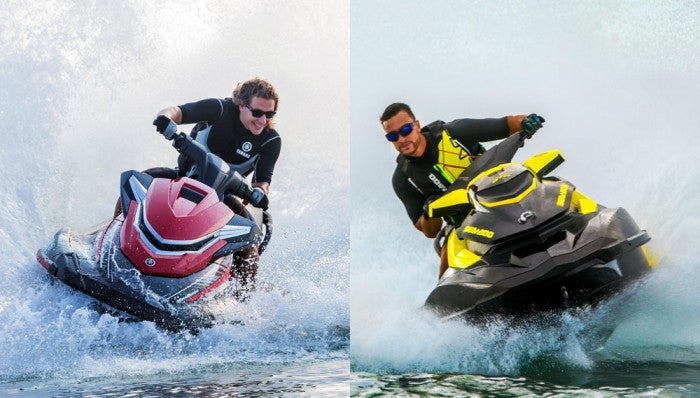
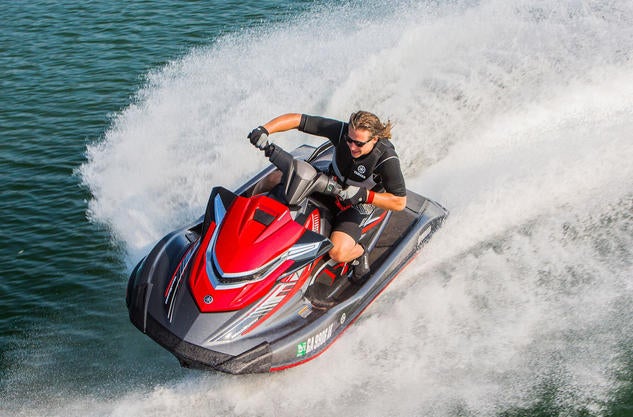
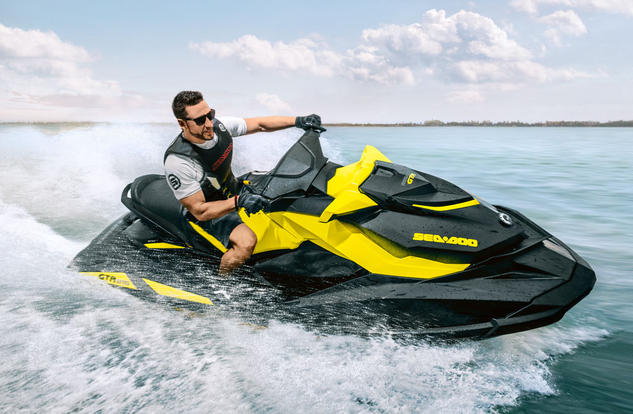
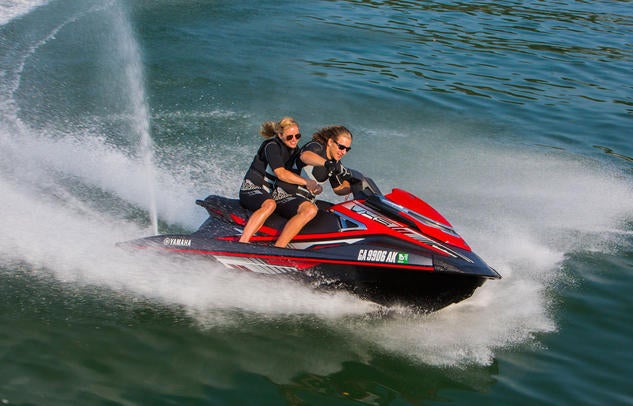
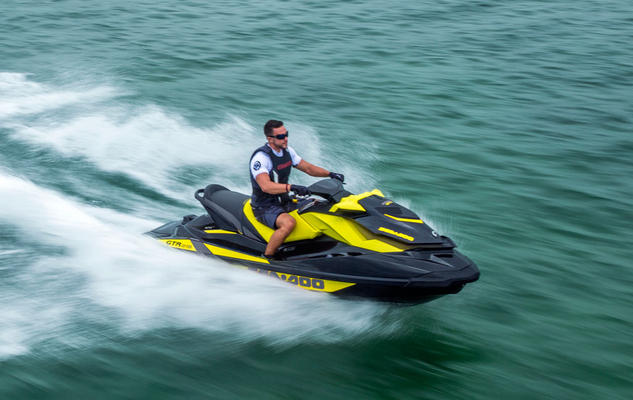








 Your Privacy Choices
Your Privacy Choices